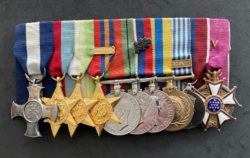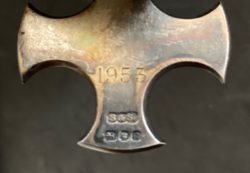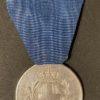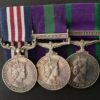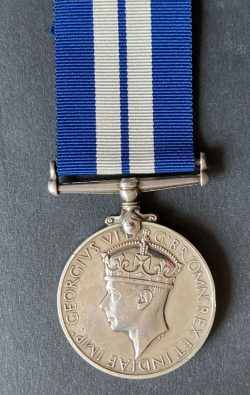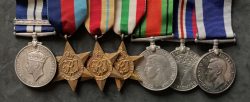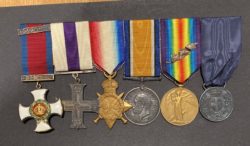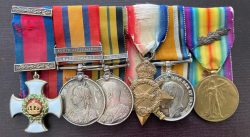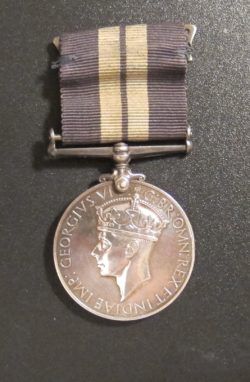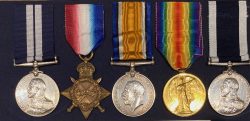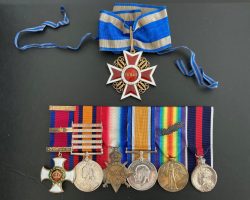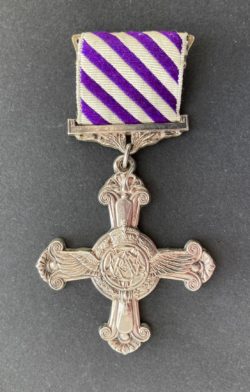E11R Distinguished Service Cross group of 10 for Korea, Commander Royal Navy and previously served aboard the destroyer Cossack as Assistant Gunnery Officer at the Altmark incident . Served as Gunnery Officer aboard the Cruiser, H.M.S. Dorsetshire and likely aboard when sunk off Ceylon along with her sister ship ‘Cornwall’ Commanded the frigate Whitesand Bay during the Korean War. Probably for the action when engaged with enemy shore batteries in the Paengyong-do area, early 1953. and additionally awarded the US Legion of Merit for Korea.
£9,850.00
1 in stock
D.S.C. (E11R) dated 1953 and hallmarked, 1939/45 Star, Atlantic Star, Burma Star bar Pacific, Defence Medal, War Medal M.I.D.), Korea (Commander D.S.C. R.N.), U.N. Korea, 1953 Coronation, U.S.A. Legion of Merit Commander
M.W.B. Craig-Waller
D.S.C. L.G. 19/5/1953: ‘For distinguished service in operations in Korean waters.’
U.S.A. Legion of Merit L.G 15/2/1955: ‘For distinguished service during operations in Korea.’
M.I.D. L.G. 11/6/1946 ‘Operations in the Far East’
Michael Waller Beaufort Craig-Waller B. Allenstown, Meath, Eire, i 1911, the son of V. Adm. Arthur Craig-Waller, R.N., qho had commanded the battleship H.M.S. Barham at Jutland.
Served as Assistant Gunnery Officer aboard Cossack at the “Altmark” incident Appointed a Midshipman, 1929 and in September 1939, was serving as a Lieutenant and Assistant Gunnery Officer in the destroyer Cossack. On 16 February 1940 that Cossack boarded and in Josing Fjord, Norway , captured the German auxiliary Altmark holdsing some 300 British merchant seamen.
As a result of delays caused by the the Altmark being in neutral waters, and the presence of two Norwegian torpedo-boats ordered to prevent British intervention, Vian had patiently awaited Admiralty orders before taking action, but then (Vian) ‘Having placed Cossack in a position from which our pom-poms could play upon Norwegian decks, whilst their torpedo tubes were no instant menace to us, I said we could parley no longer, and must board and search the Altmark forthwith, whether we fought them or not. Kjell’s captain decided that honour was served by submitting to superior force, and withdrew. On rounding the bend in the fjord, Altmark at last came into view. She lay bows inshore, encased in ice, her great bulk standing black against the snow-clad mountains. Thoughts of the six-inch guns with which the Altmark was said to be armed were naturally in our minds. Though our own guns were manned we were obviously an easy target, and the enemy’s first shots might well immobilise us at once. There was nothing for it, however, but to go ahead and get to grips as quickly as possible.
The Altmark Captain was determined to resist being boarded. On sighting Cossack, he trained his searchlight on our bridge to blind the command, and came astern at full power through the channel which his entry into the ice had made. His idea was to ram us. Unless something was done very quickly the great mass of the tanker’s counter was going to crash heavily into Cossack’s port bow. There followed a period of manoeuvring in which disaster, as serious collision must have entailed, was avoided by the skill of my imperturbable navigator, McLean, and by the speed with which the main engine manoeuvring valves were operated by their artificers. Lieutenant Bradwell Turner, the leader of the boarding party, anticipated Cossack’s arrival alongside Altmark with a leap which became famous. Petty Officer Atkins, who followed him, fell short, and hung by his hands until Turner heaved him on deck. The two quickly made fast a hemp hawser from Cossack’s fo’c’s’le, and the rest of the party scrambled across.
When Turner arrived on Altmark’s bridge he found the engine telegraphs set to full speed in an endeavour to force Cossack ashore. On Turner’s appearance, the captain and others surrendered, except the third officer, who interfered with the telegraphs, which Turner had set to stop. Turner forbore to shoot him. It was now clear that as a result of her manoeuvres Altmark would ground by the stern, which she did, but not before Cossack, the boarding party all being transferred, had cast off, to avoid the same fate. It was expected, with the surrender of the German captain, that the release of our prisoners would be a drawing-room affair. That this was not so was due to the action of a member of the armed guard which Graf Spee had put aboard. He gratuitously shot Gunner Smith, of the boarding party, in an alleyway. This invoked retaliation, upon which the armed guard decamped; they fled across the ice, and began to snipe the boarding party from an eminence on shore. Silhouetted against the snow they made easy targets, and their fire was quickly silenced by Turner and his men. In the end German casualties were few, six killed and six badly wounded. The boarding party had none, save unlucky Gunner Smith, and even he was not fatally wounded.
Resistance overcome, Turner was able to turn to the business of the day. The prisoners were under locked hatches in the holds; when these had been broken open Turner hailed the men below with the words: “Any British down there?” He was greeted with a tremendous yell of “Yes! We’re all British!” “Come on up then,” said Turner, “The Navy’s here!” I received many letters from the public after this affair: a number wrote to say that, as I had failed to shoot, or hang, the captain of Altmark, I ought to be shot myself.’ In point of fact Vian and his crew were hailed as heroes the land over, Winston Churchill setting the pace with mention of their exploits in an address to veterans of the Battle of the River Plate at the Guildhall just four days after the Altmark had been boarded:
“To the glorious action of the Plate there has recently been added an epilogue – the rescue last week by the Cossack and her flotilla – under the noses of the enemy, and amid the tangles of one-sided neutrality – the rescue of British captives from the sunken German raider – your friend, the one you sunk. Their rescue at the very moment when these unhappy men were about to be delivered over to indefinite German bondage, proves that the long arm of British sea power can be stretched out, not only to foes, but also to faithful friends. And to Nelson’s immortal signal of 135 years ago: ‘England expects that every man will do his duty’ – there may now be added last week’s not less proud reply: ‘The Navy is here!’ ” I
n March 1940, he was appointed Gunnery Officer of the destroyer Zulu, a component of the 4th Destroyer Flotilla, commanded by his old boss Philip Vian, still in Cossack, and was subsequently employed on escort work in the Atlantic.
In June 1941 he joined the cruiser Dorsetshire as Gunnery Officer and was promoted Commander in January 1942. He served aboard Dorsetshire until 5 April, 1942 when she was sunk by Japanese aerial attack.
Note. When offered some years ago mentioned as removed from Dorsetshire and hospital prior to the sinking but his service record states served aboard until April 5, the date of her sinking. More likely it may seem to have been hospitalised post sinking
In 1942, Dorsetshire, under the command of Augustus Agar, was assigned to the Eastern Fleet in the Indian Ocean. In March, Dorsetshire was assigned to Force A, which was commanded by Admiral James Somerville, with the battleship Warspite and the carriers Indomitable and Formidable. Somerville received reports of an impending Japanese attack in the Indian Ocean—the Indian Ocean raid—and so he put his fleet to sea on 31 March. Having not encountered any hostile forces by 4 April, he withdrew to refuel. Dorsetshire and her sister ship Cornwall were sent to Colombo to replenish their fuel. The next day, she and Cornwall were spotted by reconnaissance aircraft from the heavy cruiser Tone. The two British cruisers were attacked by a force of 53 Aichi D3A2 Val dive bombers 320 km (200 mi) southwest of Ceylon. In the span of about eight minutes, Dorsetshire was hit by ten 250 lb (110 kg) and 550 lb (250 kg) bombs and several near misses; she sank stern first at about 13:50. One of the bombs detonated an ammunition magazine and contributed to her rapid sinking. Cornwall was hit eight times and sank bow first about ten minutes later. Between the two ships, 1,122 men out of a total of 1,546 were picked up by the cruiser Enterprise and the destroyers Paladin and Panther the next day.
In August 1944 he was appointed to the cruiser Newfoundland, serving with the British Pacific Fleet, and was present in operations supporting the 6th (Australian) Division in the Aitape-Wewak campaign and in the attack on the Japanese naval base at Truk in the Caroline Islands. Having then taken part in the bombardment of the city of Kamaishi on 9 August 1945, Newfoundland formed part of the British force that took control of the naval base at Yokosuka. Moreover, on 2 September 1945, she was present in Tokyo Bay when the Instrument of Surrender was signed aboard the U.S.S. Missouri. Craig-Waller was mentioned in despatches.
Advanced to Commander in December 1947, he was appointed captain of the frigate Whitesand Bay in February 1952, in which capacity he was awarded the D.S.C, for his leadership and gallantry off Korea, where she was deployed with the Allied Task Group off the west coast for blockade, patrol and bombardment duties. Having then undergone a refit at Singapore, Whitesand Bay returned to the west coast of Korea in early 1953, where she came under fire from enemy shore batteries in the Paengyong-do area and delivered a 50 round response, and she was en route to the Haeju Estuary for the planned withdrawal of R.O.K. troops when the Armistice was declared that October. In the interim, she had attended the Coronation Day ceremonies in Hong Kong. Craig-Waller, who received his D.S.C. at an investiture held on 27 October 1953, was placed on the Retired List in April 1961, died Kensington, London, in July 1998.
Abbott & Tamplin, page 111 confirms 95 DSCs for 1947-79. A further 41 awarded 1980-2016.
An excellent and particularly scarce E11R Distinguished Service Cross group
